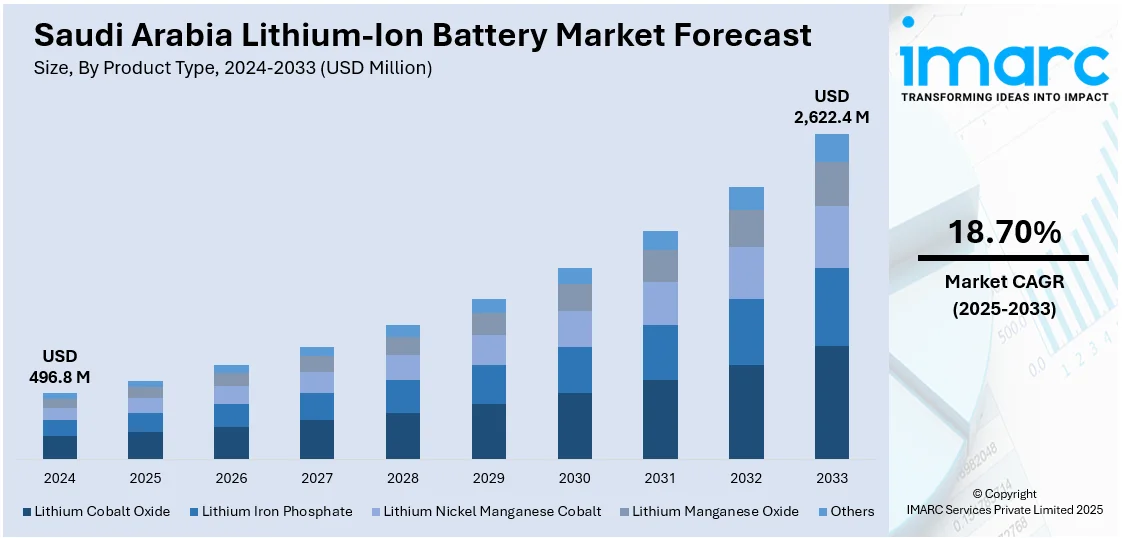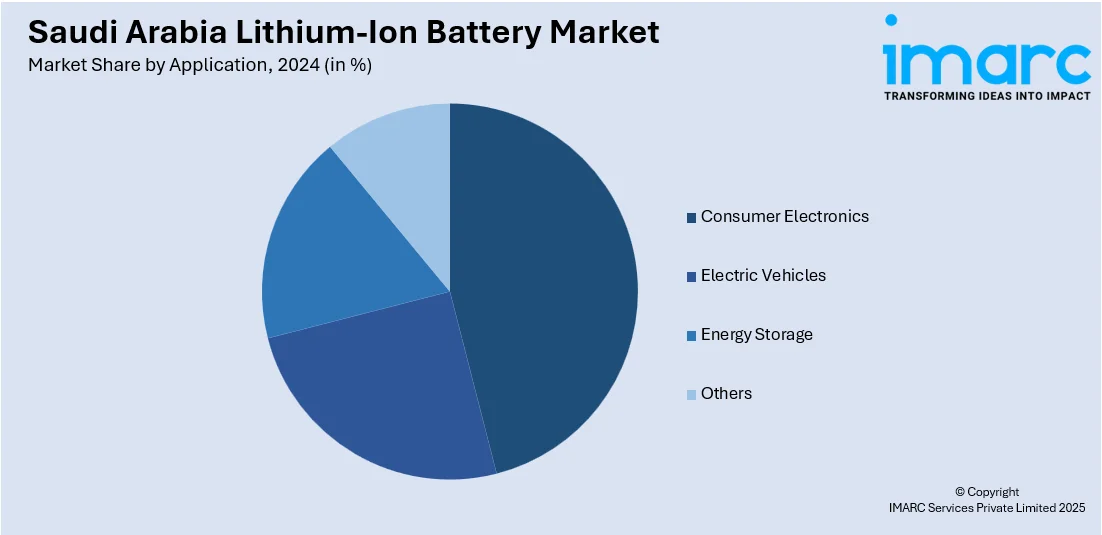
Saudi Arabia Lithium-Ion Battery Market Size, Share, Trends and Forecast by Product Type, Power Capacity, Application, and Region, 2025-2033
Saudi Arabia Lithium-Ion Battery Market Overview:
The Saudi Arabia lithium-ion battery market size reached USD 496.8 Million in 2024. Looking forward, IMARC Group expects the market to reach USD 2,622.4 Million by 2033, exhibiting a growth rate (CAGR) of 18.70% during 2025-2033. The market is driven by the growing investment in renewable energy by the governing body, the rising demand for electric vehicles (EVs), and the need for effective energy storage solutions, as Saudi Arabia aligns with Vision 2030 to reduce carbon emissions and transition to sustainable, clean energy sources.
|
Report Attribute
|
Key Statistics
|
|---|---|
|
Base Year
|
2024 |
|
Forecast Years
|
2025-2033
|
|
Historical Years
|
2019-2024
|
| Market Size in 2024 | USD 496.8 Million |
| Market Forecast in 2033 | USD 2,622.4 Million |
| Market Growth Rate 2025-2033 | 18.70% |
Saudi Arabia Lithium-Ion Battery Market Trends:
Government Support and Investment in Renewable Energy
The lithium-ion battery market is propelled by the effort of Saudi Arabia to incorporate renewable energy, particularly solar energy, into its energy framework. In line with its Vision 2030 sustainability objectives, Saudi Arabia is significantly investing in solar energy, requiring the creation of effective energy storage solutions to manage the inconsistent nature of renewable energy output. Lithium-ion batteries, recognized for their notable energy density, extended longevity, and dependability, offer the perfect solution to collect surplus solar energy and maintain a steady power supply even during periods without sunlight. The scalability and efficiency of lithium-ion batteries allow them to satisfy the growing need for energy storage in residential and commercial areas, promoting a smooth shift to cleaner energy. In 2025, BYD Energy Storage and Saudi Arabia’s SEC signed a contract for the world’s largest grid-scale battery energy storage project, totaling 15.1 GWh. The project aims to support Saudi Arabia's Vision 2030 goals by enhancing renewable energy use and grid stability. It underscores the commitment of Saudi Arabia to enhance renewable energy usage, ensuring energy security, and the essential function of advanced storage solutions such as lithium-ion batteries in meeting these goals.

Growing Demand for Electric Vehicles (EVs)
The Saudi Arabia lithium-ion battery market is largely driven by the rising demand for electric vehicles (EVs) in the region, which is part of the broader shift toward reducing carbon emissions. As countries worldwide embrace sustainable energy solutions, Saudi Arabia is actively aligning with these efforts, particularly through its Vision 2030 plan. The growing adoption of electric mobility in Saudi Arabia reflects a clear transition from traditional fossil fuel-powered vehicles to cleaner, more sustainable alternatives. Lithium-ion batteries are essential to this transition, as they power EVs efficiently and reliably. With the focus of the governing body to diversify its economy and invest in cutting-edge technologies, the demand for EV infrastructure and innovation is significantly increasing. This growing interest in EVs is accelerating the need for advanced, high-capacity battery technologies, which in turn drives up the production and utilization of lithium-ion batteries. A clear indicator of this shift is the Saudi electric car market, which reached USD 500 million in 2024 and is projected to grow to USD 2,600 million by 2033, with a compound annual growth rate (CAGR) of 17.20% from 2025 to 2033, as per the IMARC Group. This exponential growth in the EV market is further catalyzing the demand for lithium-ion batteries, emphasizing their crucial role in sustainable future of Saudi Arabia.
Saudi Arabia Lithium-Ion Battery Market Segmentation:
IMARC Group provides an analysis of the key trends in each segment of the market, along with forecasts at the regional level for 2025-2033. Our report has categorized the market based on product type, power capacity, and application.
Product Type Insights:
- Lithium Cobalt Oxide
- Lithium Iron Phosphate
- Lithium Nickel Manganese Cobalt
- Lithium Manganese Oxide
- Others
A detailed breakup and analysis of the market based on the product type have also been provided in the report. This includes lithium cobalt oxide, lithium iron phosphate, lithium nickel manganese cobalt, lithium manganese oxide, and others.
Power Capacity Insights:
- 0 to 3000mAh
- 3000mAh to 10000mAh
- 10000mAh to 60000mAh
- More than 60000mAh
The report has provided a detailed breakup and analysis of the market based on the power capacity. This includes 0 to 3000mAh, 3000mAh to 10000mAh, 10000mAh to 60000mAh, more than 60000mAh.
Application Insights:

- Consumer Electronics
- Electric Vehicles
- Energy Storage
- Others
A detailed breakup and analysis of the market based on the application have also been provided in the report. This includes consumer electronics, electric vehicles, energy storage, and others.
Regional Insights:
- Northern and Central Region
- Western Region
- Eastern Region
- Southern Region
The report has also provided a comprehensive analysis of all the major regional markets, which include Northern and Central Region, Western Region, Eastern Region, and Southern Region.
Competitive Landscape:
The market research report has also provided a comprehensive analysis of the competitive landscape. Competitive analysis such as market structure, key player positioning, top winning strategies, competitive dashboard, and company evaluation quadrant has been covered in the report. Also, detailed profiles of all major companies have been provided.
Saudi Arabia Lithium-Ion Battery Market News:
- In March 2025, scientists from King Abdullah University of Science and Technology (KAUST) revealed a breakthrough in lithium-metal batteries by incorporating nylon as an additive. This innovation enhances battery efficiency, lifespan, and safety by reducing parasitic reactions. The findings, published in ACS Energy Letters and Energy & Environmental Science, could lead to cheaper and safer battery production.
- In January 2025, Saudi Arabia connected its largest lithium-ion battery energy storage system (BESS) to the grid in Bisha, Asir province. The 500 MW/2,000 MWh facility, developed by Saudi Electric Company and built by a consortium of State Grid Corporation of China and Alfanar Projects, features lithium iron phosphate (LFP) battery modules.
Saudi Arabia Lithium-Ion Battery Market Report Coverage:
| Report Features | Details |
|---|---|
| Base Year of the Analysis | 2024 |
| Historical Period | 2019-2024 |
| Forecast Period | 2025-2033 |
| Units | Million USD |
| Scope of the Report | Exploration of Historical Trends and Market Outlook, Industry Catalysts and Challenges, Segment-Wise Historical and Future Market Assessment:
|
| Product Types Covered | Lithium Cobalt Oxide, Lithium Iron Phosphate, Lithium Nickel Manganese Cobalt, Lithium Manganese Oxide, Others |
| Power Capacities Covered | 0 to 3000mAh, 3000mAh to 10000mAh, 10000mAh to 60000mAh, More than 60000mAh |
| Applications Covered | Consumer Electronics, Electric Vehicles, Energy Storage, Others |
| Regions Covered | Northern and Central Region, Western Region, Eastern Region, Southern Region |
| Customization Scope | 10% Free Customization |
| Post-Sale Analyst Support | 10-12 Weeks |
| Delivery Format | PDF and Excel through Email (We can also provide the editable version of the report in PPT/Word format on special request) |
Key Questions Answered in This Report:
- How has the Saudi Arabia lithium-ion battery market performed so far and how will it perform in the coming years?
- What is the breakup of the Saudi Arabia lithium-ion battery market on the basis of product type?
- What is the breakup of the Saudi Arabia lithium-ion battery market on the basis of power capacity?
- What is the breakup of the Saudi Arabia lithium-ion battery market on the basis of application?
- What is the breakup of the Saudi Arabia lithium-ion battery market on the basis of region?
- What are the various stages in the value chain of the Saudi Arabia lithium-ion battery market?
- What are the key driving factors and challenges in the Saudi Arabia lithium-ion battery market?
- What is the structure of the Saudi Arabia lithium-ion battery market and who are the key players?
- What is the degree of competition in the Saudi Arabia lithium-ion battery market?
Key Benefits for Stakeholders:
- IMARC’s industry report offers a comprehensive quantitative analysis of various market segments, historical and current market trends, market forecasts, and dynamics of the Saudi Arabia lithium-ion battery market from 2019-2033.
- The research report provides the latest information on the market drivers, challenges, and opportunities in the Saudi Arabia lithium-ion battery market.
- Porter's five forces analysis assist stakeholders in assessing the impact of new entrants, competitive rivalry, supplier power, buyer power, and the threat of substitution. It helps stakeholders to analyze the level of competition within the Saudi Arabia lithium-ion battery industry and its attractiveness.
- Competitive landscape allows stakeholders to understand their competitive environment and provides an insight into the current positions of key players in the market.
Need more help?
- Speak to our experienced analysts for insights on the current market scenarios.
- Include additional segments and countries to customize the report as per your requirement.
- Gain an unparalleled competitive advantage in your domain by understanding how to utilize the report and positively impacting your operations and revenue.
- For further assistance, please connect with our analysts.
 Request Customization
Request Customization
 Speak to an Analyst
Speak to an Analyst
 Request Brochure
Request Brochure
 Inquire Before Buying
Inquire Before Buying




.webp)




.webp)












